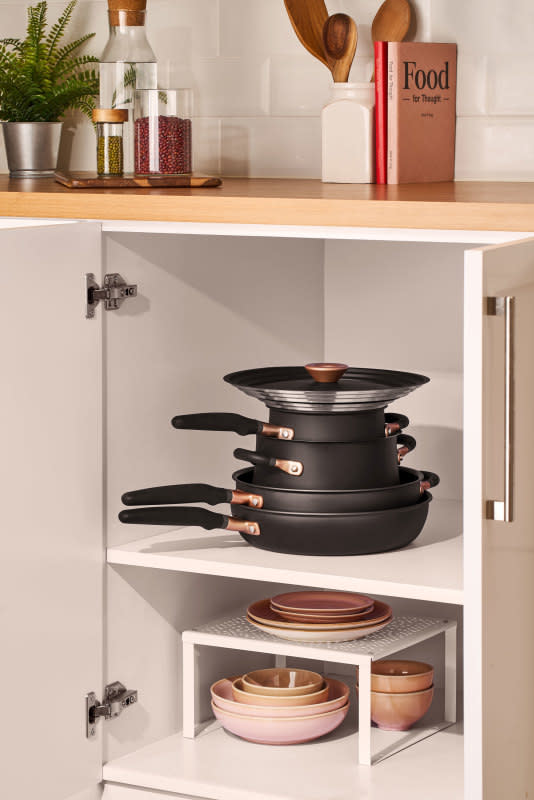How to Choose the Right Cookware For Your Induction Range
Men’s Journal aims to feature only the best products and services. If you buy something via one of our links, we may earn a commission.
Transitioning from a gas stove to an induction surface has been the best decision we made for our kitchen. (Yes, the best.) Yes, it heats fast. Yes, it's energy efficient. Yes, easy to clean, cool to the touch minutes after use, and precise as can be. I'm may be very biased toward an induction electric range, but I know that making switch to induction is often difficult due to existing cookware collections. Fortunately, many manufacturers are also making the switch to induction-compatible cookware, and in doing so, expanding the previously narrow market of affordable pots and pans. Meyer recently upgraded our collection and sent us the Essential Set in Spark, and testing each product compared to our previous stainless cookware been a real treat.
Choosing the right cookware for an induction stovetop involves considering specific characteristics, so let's look closer and determine how critical you must be:
What to Look For
It must be made of a magnetic metal. Induction ranges require cookware that has magnetic properties. Why? Induction cooktops facilitate heat conduction by creating an electromagnetic field underneath the glass cooktop surface. The ferromagnetic materials in the magnetic field then excite the molecules within the magnetic material, rapidly heating up the cookware and its contents. Pots and pans with a magnetic layer (made from materials such as stainless steel and cast iron) are reported as the best cookware for induction cooking. Enameled cast iron Dutch ovens also perform well. If you think about it this way: a gas range heats from the bottom. The contents of the pan need to circulate to reach the heat. An induction cooktop heats the whole container, expediting heat to the contents without additional circulation.
It needs to have a flat and even bottom. A flat base ensures stability and promotes efficient heat transfer from the magnetic coil. A piece of cookware with a warped or dented base will heat less evenly.
Look for cookware labeled as "induction-ready" or "induction-compatible." Manufacturers often specify which cookware lines are suitable for induction cooking to eliminate guesswork. When in doubt, do the magnet test (described below).
Quality matters. It matters a lot. It's worth it to pay more for a single quality piece than to purchase a set of allegedly induction-friendly cookware set at Home Goods. Why? Thicker pots and pans distribute heat more evenly which reduces hot spots and improves overall performance. High-quality materials like stainless steel with an aluminum or copper core are excellent choices. Plus, not only will it work well, but quality cookware materials will last longer than your bargain purchase.
Consider the size and shapes you'll use most. So, yes, you'll probably want pieces of induction-ready cookware that match the former set you owned, but also consider the size and shape of your induction cooking surfaces. For example, I only had one larger burner on my former gas range, but I have two large burners on the induction cooktop, so it opens up my options. Some induction stoves also bridge between burners to form a larger cooking zone — an induction griddle pan works really well for this scenario.
Be picky about handles and lids. You'll want tight-fitting lids to retain heat and speed cooking times, and heat-resistant handles. To save space in the kitchen, I prefer pieces with universal lids (Meyer happens to have a great set). And, speaking from experience, not all stainless steel products have heat-resistant silicone handles, so if you recall the purpose of the material, the heat from the induction burner will transfer through the entire pan including the handles. Without heat-resistant handles, the stainless steel handles will be the same temperature as the cooking pot, leading to potential burns and injury.

Meyer Cookware
The Easy Way to Test for Compatibility
Not sure if your existing cookware will work on an induction cooktop? Check to see if it will hold a magnet. Test the bottom of the pan, but also the walls up to the top of the cookware. If the magnet sticks in all places, that's a good piece. If it only sticks at the bottom but doesn't cling once you test on the sides of the pan, that's a no-go. If it doesn't hold a magnet at all, it won't work on your cooking surface. Induction only works as well as it does because the charge is transferred to all areas of the pan.
Are nonstick pans induction-compatible?
Not universally, but some induction cookware is available with a nonstick coating! We've been testing the small nonstick saucepan and large nonstick pan from Meyer Cookware and can report that it works just as well as our stainless steel pans.
Related: Three Pieces of Cookware to Use Over an Open Flame (Or On Your Backyard Grill)
